Glorious grasses
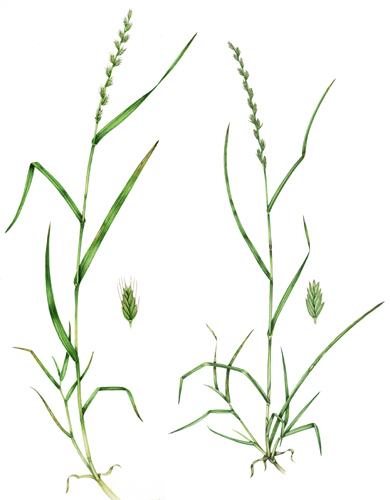
I have always loved grasses. Even as a child I marvelled at their different heights, shapes, and textures. I love the way fields of grass move and rustle in the wind, and I love the smell of new mown grass (it’s caused by green leaf volatiles (GLVs) and is actually a distress call from the plant). As an adult, I love to do botanical illustrations of them.
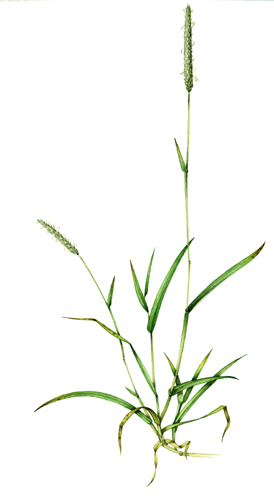
Monocots vs Dicots
In order to illustrate grasses, you need to know a bit about their anatomy. They are unlike many of our plants as they are monocots not dicots. This basically means that their seeds are formed of one cotyledon not two, but there are other more obvious differences.
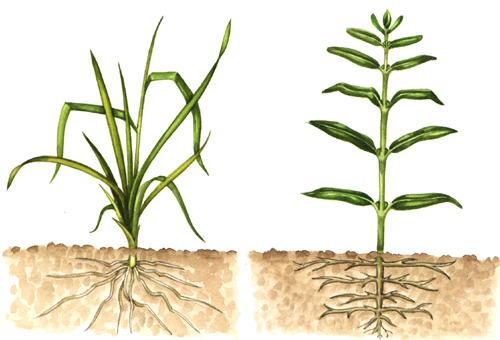
Features of Monocots
Monocot leaves grow mainly from the base of the plant, rather than up a stem. This means when they are grazed the plant does not die, and has much to do with their ubiquitous prescence and enormous success. Leaf veins run parallel rather than in a net across the leaf. The roots of monocots grow in fibrous bundles, rather than branching from one main tap root. This enables them to efficiently gather nutrients as most of these are absorbed by root hairs, which are abundant in these bundles. These roots are adventitious and spread swiftly; many moncots reproduce vegetatively by producing stolons (runners), horizontal stems which produce leaves. Below ground, monocots may have rhizomes which can produce whole new plants at their nodes. Good tactics for maximizing spread.
The vascular tissue of monocotstends to be in bundles rather than a ring (as in dicots) and never forms wood. Flowers tend to have 3 parts (or multiples of 3), whereas dicots produce these in 5s, or multiples of 5. Like the dicot plants dandelion and hazel, grasses are wind pollinated.

Grasses and wind pollination
Wind pollinated plants, for The Complete Naturalist by Nick Baker.
(For more information on monocots vs dicots please follow the Berkeley College link.
Anatomy of Grasses: The Plant
A grass plant consists of long leaves (or blades) at the base of which there may be a ligule (see below). The blades grow from a hollow and rounded stem (or culm). These stems are enclosed in the grass sheath, and jointed at the nodes. The flowering part of a grass plant is called the panicle or flower-head or (if it’s unbranched), the raceme.
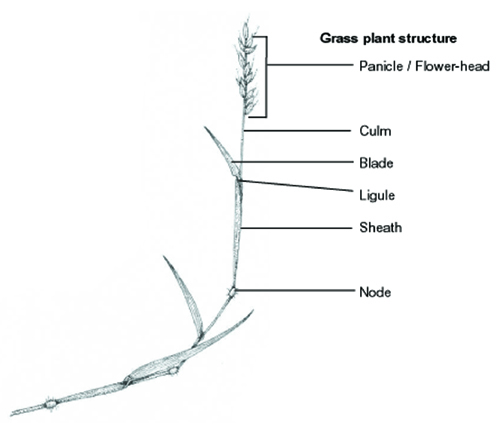
The Ligule
The ligule is a little membranous flap which can be seen at the base of the blade (occasionally represented by a fringe of hairs), where it joins the sheath (and often the stem). You may need a hand lens to see it, and in some species it is absent. However, ligule length and shape, and whether it’s smooth or torn, are crucial diagnostic tools in identifying grasses. Below are some different shapes of ligule.
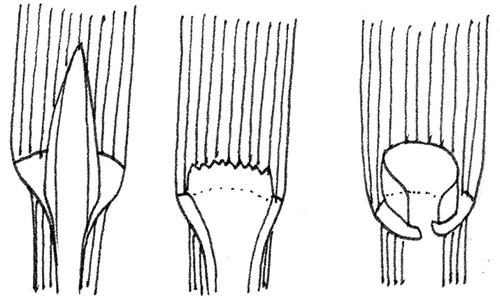
The Inflorescence
The flower-heads of grasses are formed of spikelets (individual grass flowers) which are arranged in different ways: attached to the stem with a stalk in a raceme(like false brome), or in stalked flowering spikes (like rye and wheat). Panicles occur when spikelets are borne on stalks in branching flower heads. These can be spreading (like annual meadow grass, Yorkshire fog, Cocksfoot); or compact (timothy grass, foxtails, crested dog’s hair grass).
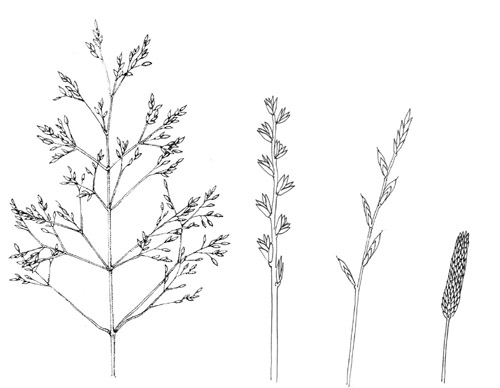
The Spikelet
The spikelet is an individual unit of a grasses flowering head, and consists of the flower enclosed by a pair of scales (glumes) which may or may not have spines (awns). Inside the glumes is the floret, which is the stamens and styles of each flower enclosed by two further scales, the lemma and the palea. These scales may have awns and may/ may not have nerves (like visible lines). Below are un-annotated and annotated diagrams of a grass spikelet.
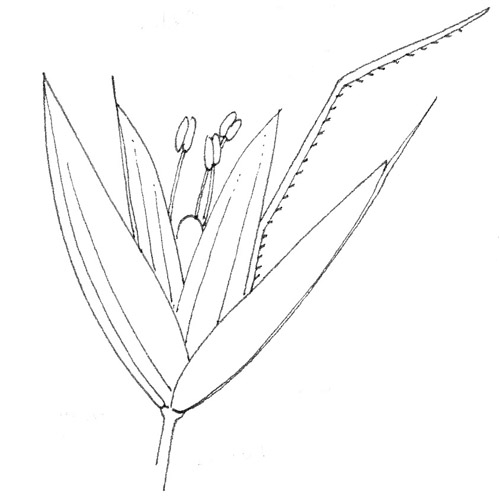
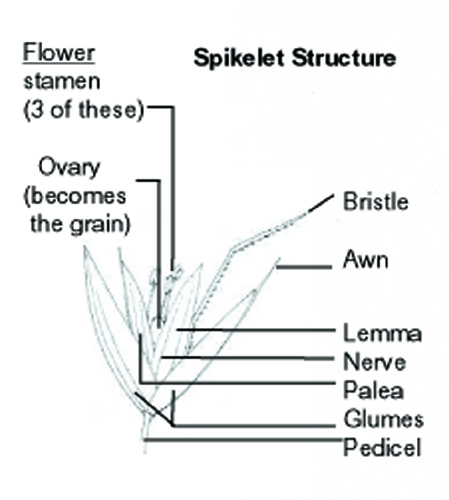
Identifying grasses species: Features to look out for
- Plant Check for habitat, the way it grows (habit), size of leaves, height, way the flower-heads are arranged and hang, season.
- Leaves Are the leaves are smooth/ hairy, inrolled or flat, their length, their width, anything interesting abour their tips (eg spiky), colour
- Ligule Look for one by gently folding the blade back from the stem. Look for it’s size, shape, edge (torn or smooth). If not there that’s another diagnostic!
- Spikelet How are these arranged on the stem? Size of individual spikelets, colour, texture, size of component parts…
- Glume Comparative size of the 2 scales, number of nerves, awns or not, size, hairy or not
- Palea and lemma Are these awned or not? How many nerves do they have?
A few amazing species of grass can produce tiny new plants from their flower heads. These are called viviparous grass and look pretty peculiar.
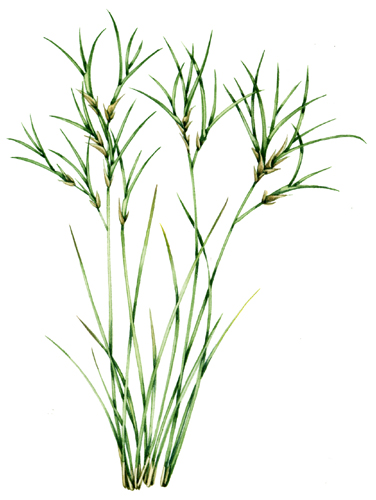
HarperCollins Flower Guide Grasses Plates
My love of grasses was ignited when I illustrated the grasses plates for the Collins Flower Guide by David Streeter. David would send me samples in the post, of ever more extraordinary and beautiful grasses. I worked closely with him, and consulted my grasses “bibles” frequently. These are C.E. Hubbard’s Grasses, Colour Identification to the Grasses, Sedges, Rushes and Ferns of British Isles and North Western Europe by Francis Rose, and Collins Guide to the Grasses, Sedges, Rushes and Ferns of Britain and Northern Europe by Fitter, Fitter and Farrer.
Below are three of the twenty or so botanical plates of grasses I did for the flower guide; they’re some of the work I am most proud of having done to date.
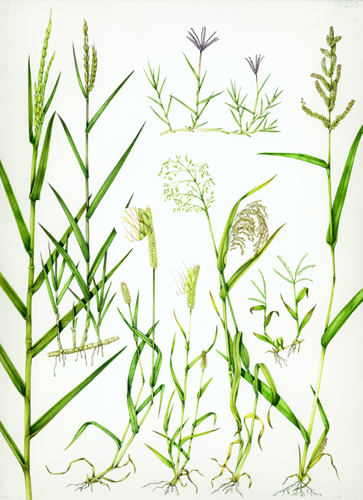
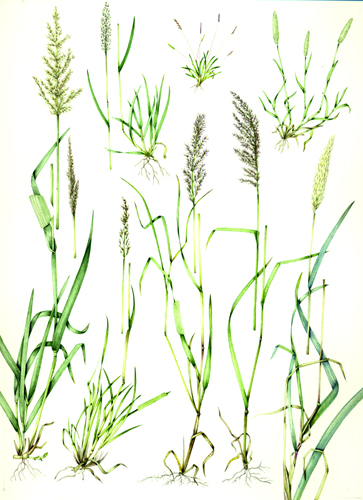
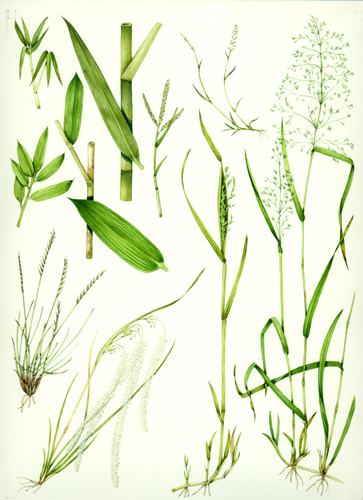
Uses of Grasses
Grasses are not the only monocot plants, but they are incredibly important to humanity and have adapted to live in habitats as diverse as sand dunes (marram), mountainous scree (alpine hair grass), and can even grow underwater (the common reed, pictured below).
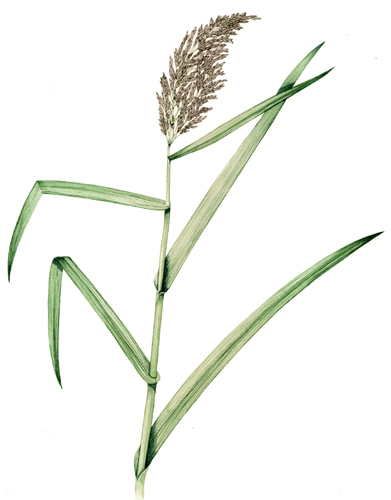
They are vital food crops; all cereals are grasses. Below are six of the most common.

My love of grasses
Despite their abundance, beauty, importance and diversity; grasses are often overlooked. They deserve more recognition, and reward interest and the time it takes to get to grips with their terminology and anatomy. They are, without doubt, one of my very favourite subjects to paint; from the pinkish flush of each spikelet of a Yorkshire fog plant to the brownish yellow areas of wear and tear on the leaf of a rye grass. You can keep your blousy roses and violet irises, I’m obsessed with the grasses and I’m happy to keep it that way.

Rye grasses x 2 Lolium perenne and Lolium multiflorum


Thank you. I have just read this as a sideline to the FSC “Introduction to Botany” course. Your drawings are not only beautiful but so helpful in a way that a photograph struggles to be.
Hi Julia,
That’s very flattering. I do lots of work for FSC, on their fold-out leaflets. The botanists who make sure I don’t make mistakes in my illustrations for the charts are the same as those who teach the botanical courses. I feel we are both in safe hands! I’m so glad this blog was useful. I find it helps me to understand the anatomy of different plant groups if I try to collate and explain the info to myself as I’ve done here. SO glad it helps others too.
Enjoy your course!
Yours
Lizzie